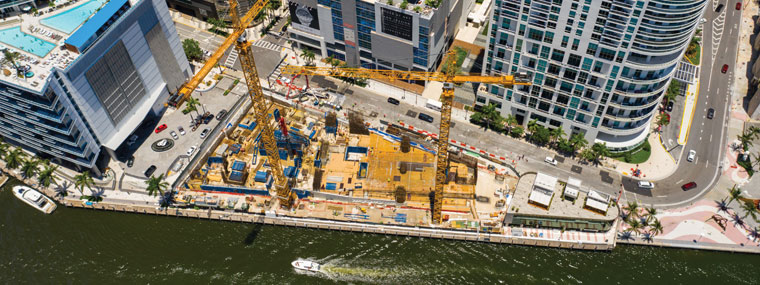
Get What You Can: Part 1
Florida Legislature Enacts A Fraction of the Surfside Taskforce Recommendations in Quadruple Overtime
By Michael J. Gelfand, Esq. / Published July 2022

Editor’s Note: This is a two-part series. Next month will address these recommendations as they apply to reserves, penalties, and more.
A billion-dollar settlement fund, appearance of major news network reporters, and the first-year anniversary of Surfside’s Champlain Towers South Condominium’s collapse may have finally pushed the Florida legislature and governor to act. After failing to move a bill to the floor during the entire regular legislative session and no action during the first three special sessions, the fourth special session appeared to be the charm.
As quadruple overtime commenced—yes, in a fourth special session since mid-March—neither building safety nor condominiums were supposed to be on the agenda. The governor’s proclamation calling the fourth special session did not mention, or even allude to, building safety. Nevertheless, literally at the last moment a parliamentary maneuver added building safety.
So, what does this mean for Florida communities. Who is affected? What must you do? When are the deadlines?
Summary
It is an 88-page bill; thus, you will be surprised by lots of details. The fact that the bill was introduced, voted for approval, and signed by the governor in less than a week means there will be many questions that have no good answers, which will need to wait for corrections during the 2023 legislative session.
Those that are affected are generally condominium and cooperative associations with buildings three stories or higher (§553.899(3)).
The WHAT that must be done are mandatory structural inspections and reserve studies. The determination of structural integrity is “of paramount importance” to avoid threats to public safety, health, or welfare (§553.899(1)). The legislature defined a “milestone inspection” as the following:
… a structural inspection of a building, including an inspection of load-bearing walls and the primary structural members and primary structural systems as those terms are defined in §627.706, by a licensed architect or engineer authorized to practice in this state for the purposes of attesting to the life safety and adequacy of the structural components of the building and, to the extent reasonably possible, determining the general structural condition of the building as it affects the safety of such building, including a determination of any necessary maintenance, repair, or replacement of any structural component of the building. The purpose of such inspection is not to determine if the condition of an existing building is in compliance with the Florida Building Code or the fire safety code (§553.899(2)(a)).
Integral to the process is another definition, “substantial structural deterioration,” which is defined as
… substantial structural distress that negatively affects a building’s general structural condition and integrity. The term does not include surface imperfections such as cracks, distortions, sagging, deflections, misalignment, signs of leakage, or peeling of finishes unless the licensed engineer or architect performing the phase one or phase two inspection determines that such surface imperfections are a sign of substantial structural deterioration (§553.899(2)(b)).
Milestone Inspections
The new law mandates two levels or phases of milestone inspections. These are identified as follows:
- Phase I. A visual inspection which must include “major structural components of a building.”
- Phase II. This is triggered if there is any sign of substantial structural deterioration (note the definition above). A Phase II inspection may include destructive testing and is to care for the following:
…fully assess areas of structural distress in order to confirm that the buildIng is structurally sound and safe for its intended use and to recommend a program for fully assessing and repairing distressed and damaged portions of the building (§553.899(7)(b)).
The WHEN is the deadline for these milestone inspections, which depends on two factors—age and location.
- Generally—Condominium and cooperative buildings that are three stories in height must complete the milestone inspection by the end of the year in which the building reaches 30 years of age and every 10 years thereafter.
- Coastal—If the condominium or cooperative building is located within three miles of a coastline, then the milestone inspection must occur by the end of the 25th year and every 10 years thereafter.
The age of a building calculation commences upon the issuance of a certificate of occupancy (§553.899(3)). If a condominium or cooperative association receives a written notice from its local enforcement agency, then there is 180 days to complete a milestone inspection (§553.899(6)).
Because there are many buildings over 30 years old, to avoid a pile-up of activity, there are some transition dates. If a condominium or cooperative building certificate of occupancy was issued on or before July 1, 1992, then the initial milestone inspection deadline is extended to December 31, 2024 (§553.899(3)).
There are some exceptions. The focus is the building’s use: single-family, two-family, and three-family dwellings with three or fewer habitable stories above ground are excluded (§553.899(3)). Note the distinction of habitable stories for the exception but not otherwise. Thus, a building with one floor that is solely for parking or (as occurs with the lowest story in the Keys sometimes) is not habitable, with only two stories with living areas, and for three families or less may be exempted. On the other hand, a condominium or cooperative building with four or more residences, with a first floor that is parking and only two habitable stories above, would still be required to have milestone inspections.
Milestone Inspection Report and Summary
Burying a bad news milestone inspection report will be difficult, if not impossible, by design. Presumably the report should be reviewed by the officers and directors and management. They should then consider corrective action, including timing and funding.
Just in case, checks and balances are incorporated into the new law. The inspecting engineer or architect’s signed and sealed milestone inspection report is to be distributed to people who would be anticipated to have an interest in ensuring that necessary work is timely undertaken and would take action if work was not properly completed: building officials and owners!
To justify action, a report must include the manner and type of inspection, identify any substantial structural deterioration as well as the extent and recommended repairs, state if there are unsafe or dangerous conditions, recommend any remedial or preventive repair for damage but not substantial structural deterioration, and identify items requiring further inspection. To help make the crux of the report easier to digest, the inspecting engineer or architect must also provide a “summary” stating the inspection report’s material findings and recommendations to the association and the local governmental building official (§553.899(8)).
The report must be delivered to the local enforcement agency. What is the “local enforcement agency” referred to in this new law? It is defined as the following:
… an agency of local government, a local school board, a community college board of trustees, or a university board of trustees in the State University System with jurisdiction to make inspections of buildings and to enforce the codes which establish standards for design, construction, erection, alteration, repair, modification, or demolition of public or private buildings, structures, or facilities (§553.71(5)).
In common terms, this will be a county or municipal building department, usually not law enforcement!
Again, in an indirect effort to pressure timely repairs, the association must also distribute the inspection report to each owner; post it at the condominium or cooperative; and if the association is required to post records on a website, then also post it on the website (§553.899(9)). Local authorities may enact further deadlines and penalties for failing to meet deadlines (§553.899(10)). Generally, repairs must be within one year within the report being filed (§553.899(11)).
Michael J. Gelfand, Esq.
Senior Partner, Gelfand & Arpe, P.A.
Michael J. Gelfand, Esq., the senior partner of Gelfand & Arpe, P.A., emphasizes a community association law practice, counseling associations and owners how to set legitimate goals and effectively achieve those goals. Gelfand is a dual Florida Bar board certified lawyer in condominium and planned development law and in real estate law, a certified circuit and county civil court mediator, homeowners association mediator, an arbitrator, and parliamentarian. He is a past chair of the Real Property Division of the Florida Bar’s Real Property, Probate & Trust Law Section, and a Fellow of the American College of Real Estate Lawyers. Contact him at ga@gelfandarpe.com or (561) 655-6224.




